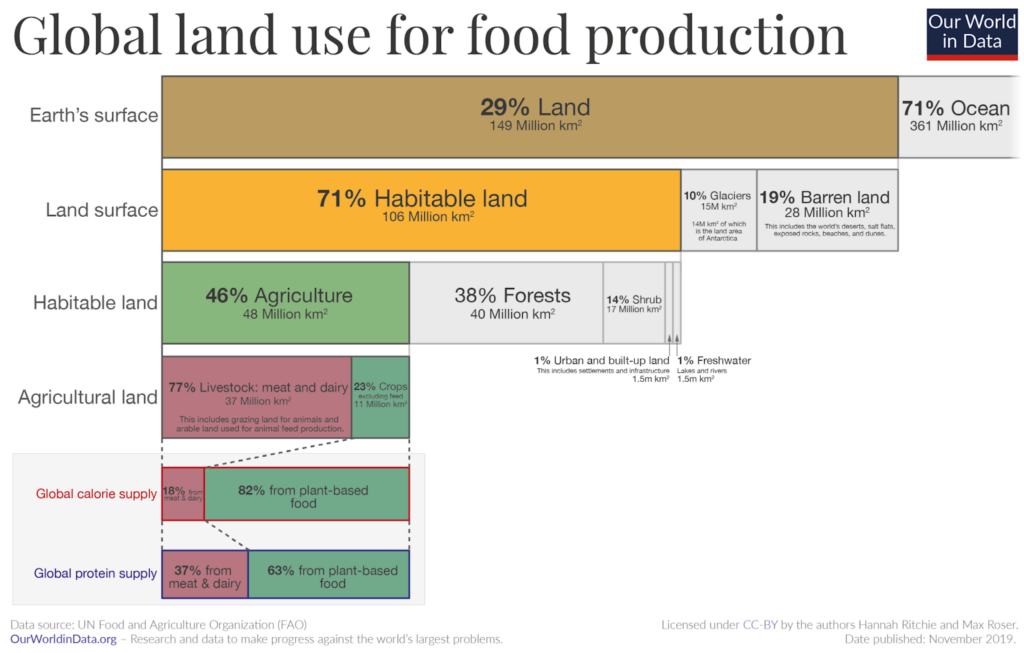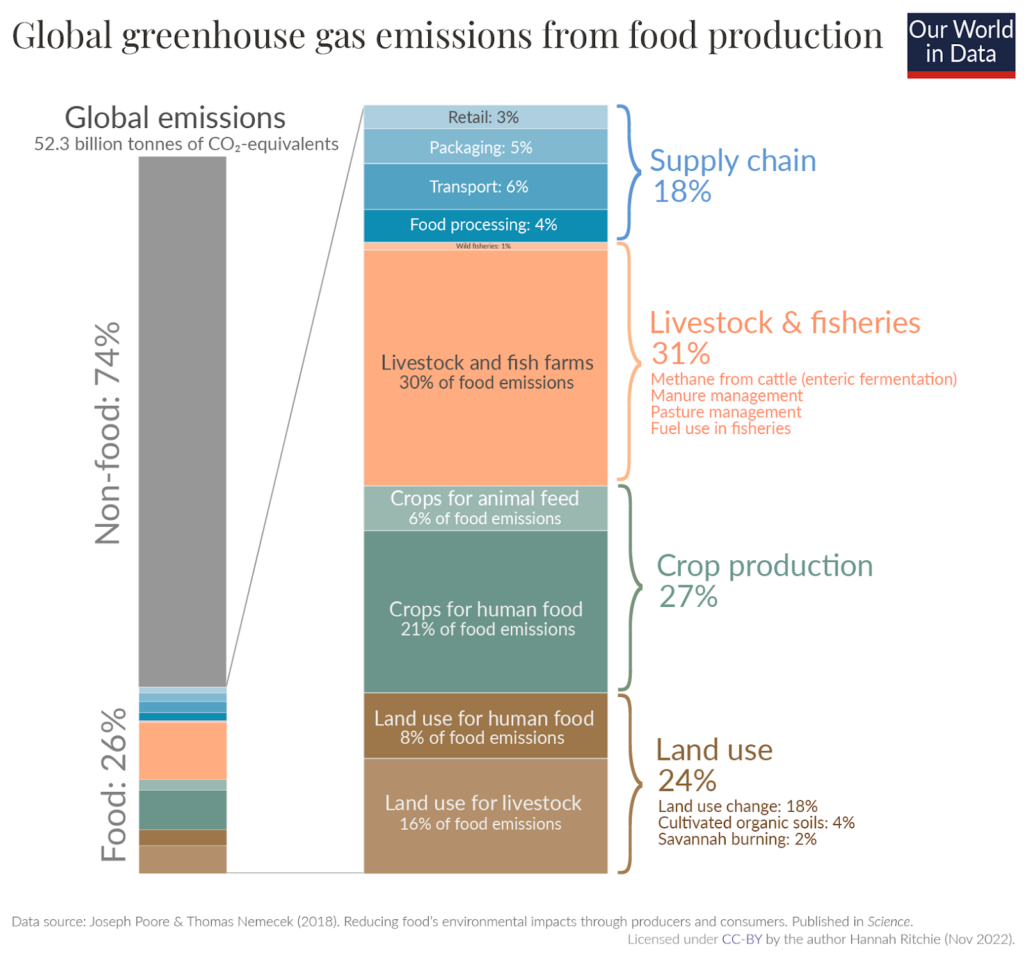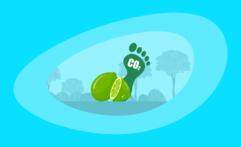Is Eating Cantaloupes Ethical & Sustainable? Here Are the Facts
Affiliate Disclosure
Hey fellow impactful ninja ?
You may have noticed that Impactful Ninja is all about providing helpful information to make a positive impact on the world and society. And that we love to link back to where we found all the information for each of our posts.
Most of these links are informational-based for you to check out their primary sources with one click.
But some of these links are so-called "affiliate links" to products that we recommend.
Why do we add these product links?
First and foremost, because we believe that they add value to you. For example, when we wrote a post about the environmental impact of long showers, we came across an EPA recommendation to use WaterSense showerheads. So we linked to where you can find them. Or, for many of our posts, we also link to our favorite books on that topic so that you can get a much more holistic overview than one single blog post could provide.
And when there is an affiliate program for these products, we sign up for it. For example, as Amazon Associates, we earn from qualifying purchases.
What do these affiliate links mean for you?
First, and most importantly, we still only recommend products that we believe add value for you.
When you buy something through one of our affiliate links, we may earn a small commission - but at no additional costs to you.
And when you buy something through a link that is not an affiliate link, we won’t receive any commission but we’ll still be happy to have helped you.
What do these affiliate links mean for us?
When we find products that we believe add value to you and the seller has an affiliate program, we sign up for it.
When you buy something through one of our affiliate links, we may earn a small commission (at no extra costs to you).
And at this point in time, all money is reinvested in sharing the most helpful content with you. This includes all operating costs for running this site and the content creation itself.
What does this mean for me personally?
You may have noticed by the way Impactful Ninja is operated that money is not the driving factor behind it. It is a passion project of mine and I love to share helpful information with you to make a positive impact on the world and society. However, it's a project in that I invest a lot of time and also quite some money.
Eventually, my dream is to one day turn this passion project into my full-time job and provide even more helpful information. But that's still a long time to go.
Stay impactful,
Cantaloupe is a popular fruit in the US, with over 1 billion pounds produced each year. They’re also a source of many major nutrients, such as potassium, vitamin C, and vitamin A. However, cantaloupes can also have some seriously unethical and unsustainable components to their production. So, we had to ask: Is eating cantaloupes ethical and sustainable?
Eating cantaloupes is fairly unethical. The industry has some reports of child labor in Mexico and Honduras, as well as reports of poor working conditions. However, there are fewer reports of these things occurring in the US.
Eating cantaloupes is moderately unsustainable. This is mainly because of their use of monoculture farming methods, high irrigation requirements, and use of nitrogen fertilizer. However, they have low pesticide usage and don’t use plastic packaging.
In this article, we will assess both the ethical and sustainability practices of the cantaloupe industry. Through these two lenses, you will be able to gain in-depth knowledge of the overall impacts of the cantaloupes that you eat!
Here’s How We Assessed the Ethics & Sustainability of Cantaloupes
The Sustainability Assessment of Food and Agriculture Systems (SAFA) is one of the ways we measure the externalities of our actions, like the consumption of cantaloupes. It is a holistic assessment based on the potential impact of food and agriculture operations on the environment and people. Those impacts are changes in our environment that can have adverse effects on the air, land, water, fish, and wildlife or the inhabitants of the ecosystem.
“Ethical: The discipline concerned with what is morally good and bad and morally right and wrong”
Encyclopedia Britannica
Ethics and sustainability are closely interconnected concepts that share a common objective: the well-being and preservation of our planet, including all its life and future generations.
“Sustainable: The ability to be maintained at a certain rate or level | Avoidance of the depletion of natural resources in order to maintain an ecological balance”
Oxford Dictionary
Basically, all goods and services you buy—including cantaloupes—leave an impact on people, animals, and our environment. And when it comes to food in general—and cantaloupes in specific—the following are key factors for their ethics and sustainability:
- Social and economic conditions: The ethics of food crucially depends on the social and economic conditions of the farmers who grow them. Especially on fair labor practices, including fair wages and safe working conditions.
- Seasonality: Eating seasonally is a lever of sustainability. The two key reasons are that seasonal food is more likely grown in their “natural growing season” without using greenhouses, and also more likely to be grown locally.
- Land requirements: Large parts of the world that were once covered by forests and wildlands are now used for agriculture. 10 million hectares of forest are destroyed annually and 50% of the world’s habitable land is now used for agriculture. This loss of natural habitat has been the main driver for reducing the world’s biodiversity.
- Water footprint: 70% of global freshwater is now used for agricultural purposes. By assessing the water footprint of a particular food, we can determine how our limited freshwater resources are being consumed and polluted.
- Pesticide and fertilizer usage: Pesticides and fertilizers provide a range of agricultural benefits. However, numerous studies link pesticides and fertilizers to serious effects on human health, along with disruptions to vital ecosystems and the spread of aquatic dead zones.
- Carbon footprint: The carbon footprint is one of the ways we measure the effects of our human-induced global climate change. Today, food production accounts for over a quarter (26%) of global greenhouse gas emissions.
- Waste generation: Food and its packaging account for almost 45% of the materials landfilled in the US alone. And packaging sent to landfills, especially when made from plastics, does not degrade quickly or, in some cases, at all.
To understand the overall ethics and sustainability of cantaloupes, we must assess each of their key factors. This Sustainability Assessment of Food and Agriculture Systems (SAFA) is a tool developed for assessing the impact of food and agriculture operations on the environment and people. And this tool helps us to evaluate whether eating cantaloupes is ethical & sustainable.
Here’s How Ethical & Sustainable Eating Cantaloupes Is
The overall ethics & sustainability of cantaloupes is fairly low. The main factors that contribute to this are their reports of child labor in Honduras, high irrigation requirements, monoculture farming, nitrogen fertilizer usage, and high carbon footprint.
Cantaloupes do have some positive qualities when it comes to ethics and sustainability. For example, there are no major reports of child labor in the US cantaloupe industry, and they don’t use a significant amount of pesticides or plastic packaging. However, they still have many other qualities that are very unethical and unsustainable.
So, let’s have a look at the ethics & sustainability impact of each key factor of cantaloupes!
| Key Assessment Factors | Ethics & Sustainability |
| Social and economic conditions of cantaloupes | Cantaloupes’ social and economic conditions are fairly poor. There have been reports of child labor, as well as dangerous conditions and wage theft, particularly in Honduras. |
| Seasonality of cantaloupes | Cantaloupes’ seasonality is between June and August. This means that they are more sustainable to buy during this period, outside of which they are typically imported from Guatemala. |
| Land requirements for cantaloupes | Cantaloupes’ land requirements are high. They also use harmful monoculture farming methods and have been identified as a threat to wetlands, making them moderately unsustainable. |
| Water footprint of cantaloupes | Cantaloupes have a water requirement of 50–100 inches of water per year. Because of where they grow, they need a significant amount of irrigation to make up for this. As such, their water footprint is very negative. |
| Agrochemical usage for cantaloupes | Cantaloupes’ agrochemical usage is moderate overall. Their pesticide usage is low, but their use of nitrogen fertilizer is particularly harmful to the environment. |
| Carbon footprint of cantaloupes | The carbon footprint of cantaloupe is high at 0.58kg (1.3lb) of CO2e per pound of cantaloupe. This is mainly because of their low land density, high irrigation requirements, refrigeration during transportation, and low composting rates. |
| Waste generation of cantaloupes | Cantaloupes’ waste generation is moderate. They have low composting rates but use cardboard packaging, which has a high recycling rate. |
These are the overall summaries, but there is a lot more to the story. In the next few sections, we will dive deeper into each stage to illustrate to you all the important aspects of cantaloupes’ ethics & sustainability.
How Ethical & Sustainable Are the Social and Economic Conditions for Cantaloupes
Cantaloupes’ social and economic conditions are fairly poor. There have been reports of child labor, as well as dangerous conditions and wage theft, particularly in Honduras.
Everything we consume was made or harvested by somebody. In past centuries, this was often someone who lived in your community and who you might have even known personally. But through the rise of globalized distribution systems, we have become increasingly alienated from the people who make our food. This leaves a lot of room for exploitation and abuse, both of which are rampant in the food industry. Here, we will look at how the cantaloupe industry fares in relation to these ethical questions.
How ethical & sustainable are the social and economic conditions of growing cantaloupes?
- Are farmers paid fair wages to grow cantaloupes: As of 2020, cantaloupe harvesters made around $14 per hour in California. However, since the California minimum wage is now $15.50, this may have gone up. This is a decent wage within California, though much of the work tends to be seasonal and so earnings can be inconsistent.
- How safe are the working conditions to grow cantaloupes: There have been major reports of difficult working conditions in Honduras’ cantaloupe farms. These reports specifically allege wage theft and exposure to unsafe chemicals as the main dangers facing workers. In the US, climate change and its impact on crop consistency is making work more unstable and scarce for cantaloupe pickers.
- Are there reports of child or forced labor to grow cantaloupes: There have been reports of child labor on Honduras’ melon farms. There have also been reports of child labor on cantaloupe farms in Mexico, Panama, and Paraguay.
- What is the wider economic impact on the communities that grow cantaloupes: Many agricultural workers in California are predominantly migrant workers, people from Mexico or Central America who come to the US on a work visa. This program can help many find work, but it can also leave room for exploitation, especially if the workers are undocumented, which many are.
In short, many aspects of cantaloupe farming have serious ethical concerns, such as child labor, wage theft, and poor working conditions, particularly in Honduras.
How Ethical & Sustainable Are the Seasonality for Cantaloupes
Cantaloupes’ seasonality is between June and August. This means that they are more sustainable to buy during this period, outside of which they are typically imported from Guatemala.
Every fruit has a natural season in which they grow, usually lasting a couple of months, which can range depending on the region. However, international demand for every kind of fruit is year-round. This demand is often met by importing fruits from tropical places which can grow year-round, or by growing them in greenhouses. Both of these methods use more resources and are thus less sustainable than conventional farming. Here, we will look at how the cantaloupe industry accommodates year-round demand.
How ethical & sustainable is it to grow cantaloupes in-season vs out-of-season?
- When is the natural season for growing and harvesting cantaloupes: Cantaloupes are in season from June to August. This means that they will be more plentiful, especially locally-grown, during that time.
- How are cantaloupes naturally grown in-season: Cantaloupes grow on vines on the ground. In-season, they are predominantly grown in California. This means that if you buy cantaloupe in the summer, it is more likely to be grown in California.
- How are cantaloupes grown out-of-season: Out-of-season cantaloupes come predominantly from Guatemala. This means that, in the off-season, they need to be transported further and are thus less sustainable.
In short, cantaloupes’ summer season means that they are typically imported the rest of the year from Guatemala, making them less sustainable during this time.
How Ethical & Sustainable Are the Land Requirements for Cantaloupes
Cantaloupes’ land requirements are high. They also use harmful monoculture farming methods and have been identified as a threat to wetlands, making them moderately unsustainable.

The growth stage has a major impact on fruits’ sustainability. The amount of land used, especially in relation to its expansion, the method with which they are grown, and their effect on surrounding land and wildlife are all important factors. In this section, we will look at the ways in which cantaloupes’ land usage affects their sustainability.
How ethical & sustainable are the land requirements for growing cantaloupes?
- What is the land usage of cantaloupes: Cantaloupes produce about 15 tons of fruit per hectare. This is a relatively low yield compared to other fruits. For example, strawberries yield around 15-25 tons per hectare. This lower land yield may lead to increased space and resources being allocated to cantaloupes, which decreases their sustainability.
- Where and how are cantaloupes grown: Most cantaloupes grow in Guatemala. Cantaloupes are part of the pumpkin and squash family, meaning that they grow in vines along the ground. These kinds of crops can sequester carbon using photosynthesis, which is the process of capturing carbon from the atmosphere and storing it in the ground. This lowers their carbon footprint and raises their sustainability.
- Are cantaloupes grown in monocultures or polycultures: Cantaloupes are predominantly grown in monoculture farms, meaning they are the only crop present in their area. Monocultures are very damaging to the environment and so cantaloupes’ growing method is very unsustainable.
- How does the growing of cantaloupes affect soil fertility and erosion: Melons like cantaloupe have actually proven to have a positive effect on soil, even in monocultures. For example, they have occasionally been used in soil revitalization projects because of their ability to curb soil erosion.
- How does the cantaloupe industry affect the loss of habitable land: Cantaloupes have been found to contribute to land loss by draining wetlands. In many places, especially in New Zealand, cantaloupes are occasionally grown on former wetlands, leading to the loss of that important piece of the ecosystem.
- How does the cantaloupe industry affect wildlife and biodiversity: Wetlands are home to many different species, and so their destruction affects a great number of wildlife species. Monoculture farming is also very damaging to biodiversity, especially pollinators because they limit the growth of many important soil microbes and deplete pollinators of the diverse nutrients they need to thrive.
In short, cantaloupes’ use of monoculture farming and participation in wetland destruction means they are moderately unsustainable.
How Ethical & Sustainable Is the Water Footprint of Cantaloupes
Cantaloupes have a water requirement of 50–100 inches of water per year. Because of where they grow, they need a significant amount of irrigation to make up for this. As such, their water footprint is very negative.
Water usage is one of the most important factors in a fruit’s sustainability. Practices like irrigation use significant resources and can cause pollution, and as such, factors like the amount of water used, where it is sourced, as well as the way they affect the water sources around them, are all important. Here, we will look at these different angles of cantaloupes’ water footprint.
How ethical & sustainable is the water footprint of growing cantaloupes?
- What is the overall water usage of cantaloupes: Cantaloupes need about 50–100 inches of water per year. This is one of the higher needs among fruits and so their water footprint is relatively large.
- What is the green water footprint of cantaloupes: The green water footprint is the amount of water from precipitation stored in the soil and used by plants for growth. Most American cantaloupes are grown in California. However, California only gets a meager 22 inches of rain per year, which nowhere near covers cantaloupes’ water requirements. Therefore, all the rainfall in the area will need to be used toward cantaloupe farming. Thus, their green water footprint is very high.
- What is the blue water footprint of cantaloupes: The blue water footprint is the amount of water sourced from surface (such as rivers or lakes) or groundwater resources. Since California’s rainfall does not cover cantaloupes’ water needs, they will need significant irrigation. As a result, their blue water footprint is very high.
- What is the gray water footprint of cantaloupes: The gray water footprint is the amount of freshwater required to clean up water pollution to meet certain quality standards. Essentially, it’s the amount of water needed to make polluted water clean enough to be safe and healthy for humans and the environment. Cantaloupes were included on a list of fruits with the lowest amount of pesticides. Therefore, they don’t need a significant amount of water to clear up any residue, giving them a low gray water footprint.
- How does the cantaloupe industry affect freshwater and ocean pollution: Cantaloupes use nitrogen fertilizer, which is very damaging to waterways. Nitrogen in waterways can lead to ocean dead zones. These are very dangerous to the entire planet’s ecosystem.
In short, cantaloupes’ extremely high irrigation requirements, as well as their use of nitrogen fertilizer, means that they are very unsustainable at this stage.
How Ethical & Sustainable Is the Agrochemical Usage for Cantaloupes
Cantaloupes’ agrochemical usage is moderate overall. Their pesticide usage is low, but their use of nitrogen fertilizer is particularly harmful to the environment.
Pesticides and fertilizers are agrochemicals that are very unsustainable and damaging to ecosystems. This is because they require resources to create and can easily run off into groundwater and soil systems. Here, we will look at how sustainable cantaloupes’ pesticide and fertilizer rates really are.
How ethical & sustainable is the agrochemical usage of growing cantaloupes?
- What is the pesticide usage of cantaloupes: Cantaloupes have a very low rate of pesticide use. This means that they avoid many of the unsustainable qualities of pesticides.
- What is the fertilizer usage of cantaloupes: Cantaloupes use a significant amount of nitrogen, especially when they are first growing. Once they are mature, they don’t need as much nitrogen, but they still use a significant amount of it throughout their life. Nitrogen is one of the more harmful fertilizers out there and so fertilizer is very unsustainable.
- Are there any known issues connected to the agrochemical usage for cantaloupes: Nitrogen fertilizer has been associated with invasive algae growth, which can harm many kinds of aquatic life. This has a devastating effect on ecosystems and thus is very unsustainable.
In short, though cantaloupes have very low pesticide rates, their use of nitrogen fertilizer means that they have a moderately negative agrochemical impact.
How Ethical & Sustainable Is the Carbon Footprint of Cantaloupes
The carbon footprint of cantaloupe is high at 0.58kg (1.3lb) of CO2e per pound of cantaloupe. This is mainly because of their low land density, high irrigation requirements, refrigeration during transportation, and low composting rates.

Carbon footprint is one aspect of the overall sustainability of a fruit. It essentially measures how much carbon or other greenhouse gasses the production of fruits emits into the atmosphere. Emissions from product manufacturing, irrigation, transportation fuel, and landfills all add up to create the overall carbon footprint of a fruit. Let’s see how the carbon footprint of cantaloupes contributes to their overall sustainability.
How ethical & sustainable is the carbon footprint of cantaloupes?
- What is the overall carbon footprint of cantaloupes: The overall carbon footprint of cantaloupes is 0.58kg (1.3lb) of CO2e per pound of cantaloupe. This means that for every pound of cantaloupes produced, 0.58kg of carbon is released into the atmosphere. This is a very high carbon footprint compared to other fruits.
- What are the main contributors to the carbon footprint of cantaloupes: The main factors that contribute to cantaloupes’ carbon footprint are their low land yield, high irrigation requirements, and refrigerated transportation.
- Which life-cycle stage of cantaloupes has the highest carbon footprint: The stage that contributes the most to cantaloupes’ footprint is growth, due to the amount of resources required during the process, such as land requirements and high irrigation needs.
In short, cantaloupes’ use of excessive irrigation, refrigerated transport, and other resources means that they have one of the highest carbon footprints among fruits.
How Ethical & Sustainable Is the Waste Generation of Cantaloupes
Cantaloupes’ waste generation is moderate. They have low composting rates but use cardboard packaging, which has a high recycling rate.
When fruit waste, either in the form of packaging or organic materials, is disposed of, it can cause a lot of problems. Whether it’s damaging wildlife, getting into oceans, emitting methane, or dissolving into microplastics that contaminate groundwater, all these materials have their part to play. The sheer amount of waste we produce is reaching a crisis point and won’t be able to continue much longer. In this section, we will look at how sustainable cantaloupes’ waste generation is.
How ethical & sustainable is the waste generation of cantaloupes?
- What is the packaging of cantaloupes: Cantaloupes are mainly packed together in large cardboard boxes and then sold to the consumer without packaging. Cardboard is fairly unsustainable during its manufacturing because it contributes to deforestation.
- How is the packaging of cantaloupes disposed of: Cardboard has a very high recycling rate at 89%, meaning that the majority of cantaloupe packaging isn’t ending up in landfills, which is good news. However, there are still some negative unsustainable qualities to recycling, such as the amount of resources it requires. Therefore, though cantaloupes use the lowest-impact type of packaging, they are still less sustainable than fruits that use no packaging at all.
- How are cantaloupes disposed of: Cantaloupes have rinds and seeds that are generally not eaten. These can be composted, but in practice, only 4% of food waste is actually composted. This means that the vast majority of cantaloupe waste is ending up in landfills. Landfills are not only generally unsustainable, but food waste in landfill is especially harmful. This is because food releases the harmful greenhouse gas methane when it goes into the landfill. As a result, organic waste from cantaloupes is considerable.
In short, cantaloupes have a high recycling rate due to their packaging, but a low composting rate due to their organic waste, altogether making for a moderate waste impact.
What Have Been Historical Ethics & Sustainability Issues Connected to the Cantaloupes Industry
The cantaloupe industry has historically had a destructive effect on the environment, particularly in relation to California’s wetlands. Therefore it is very unsustainable.
All fruits have had a complex road toward global distribution. They originate in one part of the world and often travel far to end up in your local supermarket. From farm to table, some of our favorite fruits have used unsustainable practices. Whether it’s exploiting labor, deforestation to meet demand, water pollution, or disruption of wildlife, most fruits have left a path of destruction. Many of these effects are still felt today or have even increased. Let’s see how cantaloupes have fared throughout history.
What have been the key ethical & sustainable issues of the cantaloupe industry?
- Has labor been exploited because of cantaloupe production: One of the most famous events in cantaloupe labor history was the California strike of 1928. That year, Mexican farm workers on California’s melon farms went on strike for wage increases and better working conditions. From this case, we can see how cantaloupe workers have been fighting for their rights for at least a century.
- How much land has been lost because of cantaloupe production: The fact that cantaloupes are often farmed on former wetlands is very bad for the environment, especially in California. Over the past hundred years, over 90% of wetlands in California have been destroyed, which is posing a serious threat to the state’s ecosystem.
- Which wildlife species have been negatively impacted or displaced because of cantaloupe production: California’s wetlands are home to some of the state’s most important wildlife species. A whopping 55% of California’s endangered species are wetland wildlife, which demonstrates how much agriculture has decimated the state’s biodiversity over the past century.
- Have water sources and soil been contaminated because of cantaloupe production: Nitrogen fertilizer is a major threat to waterways everywhere. It moves easily through waterways, causing pollution and the growth of invasive species. Many waterways have been polluted through agriculture’s heavy use of nitrogen fertilizer over the years.
- Other known historical issues: Cantaloupes have a large waste problem at the farm level as well as the consumer level. Due to shrinking profit margins, some farmers are leaving up to 30% of their harvest to soil in the field, leading to an uptick in methane and resource waste. This has been a huge issue in cantaloupe farming, touching on economic issues in farming, as well as environmental ones.
In short, the history of cantaloupe agriculture, especially in California, has left a serious path of destruction in its wake. Its destruction of wetlands has been one of its worst aspects.
How Can You Reduce Your Environmental Impact and Offset Your Personal Carbon Footprint
There are a few things you can do to make your cantaloupe consumption more ethical and sustainable, while still enjoying them. You can also consider offsetting your personal and cantaloupe-related carbon emissions, which work to remove carbon emissions elsewhere that are then attributed to you. Here, we will walk you through how to accomplish both of these things.
How Can You Shop for Cantaloupes More Ethically & Sustainably
In this section, we give you a short list of ways you can consume cantaloupes in a more sustainable way. This list is designed to target the most unsustainable parts of cantaloupes’ life-cycle:
- Buy in-season cantaloupes: Cantaloupes are typically grown domestically between June and August, making them much more sustainable during that time, since they don’t need to be imported. Thus, they will be much more sustainable during this time. Furthermore, US-grown cantaloupe farming doesn’t have reports of child labor or unethical conditions for workers.
- Buy organic cantaloupes: Cantaloupes don’t use a lot of pesticides, but they are big offenders when it comes to nitrogen fertilizer. Nitrogen fertilizers contribute significantly to cantaloupes’ sustainability and so it’s important to find ways to reduce it. Organic farms generally avoid high amounts of nitrogen fertilizers and so they are good to support if you want to reduce your fertilizer impact.
- Compost and recycle: Cantaloupe rind generally isn’t eaten, however it can be composted. If your local area doesn’t have a government run composting scheme or recycling program, then try composting your own waste and using the cardboard as roughage.
Following some of these methods can really help you to make your cantaloupe-eating more sustainable. None of these will completely eradicate the negative impacts, since there are always effects that may be outside of your control. But some reduction is always better than nothing!
Which Organizations Can You Support to Help Promote Ethics & Sustainability
While cantaloupe production engages in some very unsustainable practices, there are also some organizations that help you change the parts of these processes that would otherwise be outside of your control. These organizations are working hard to prevent and reverse damage to the environment caused by industries like cantaloupe agriculture, towards a more sustainable future.
In the table below are some of the best charities that work in the areas where cantaloupe production are very unsustainable—and beyond:
Though it is helpful to boost the sustainability of your personal cantaloupe consumption, supporting these organizations takes your positive impact a step further. You will be reaching far beyond your own consumption impacts and helping to build a better world for everyone!
How Can You Offset Your Personal Carbon Footprint
The carbon footprint is a key part of how sustainable we live. And it is one of the ways we measure the effects of our human-induced global climate change. Yes, even from eating cantaloupes!
“Carbon footprint: the amount of greenhouse gasses and specifically carbon dioxide emitted by something (such as a person’s activities or a product’s manufacture and transport) during a given period”
Merriam Webster
Basically, it is the amount of carbon emitted by you as an individual or an organization providing you with goods and services – including cantaloupes:
- This includes GHG emissions from producing the products that we use and foods that we eat (e.g., power plants, factories or farms, and landfills)
- GHG emissions from fuel that we burn directly or indirectly (e.g., logistics and transportation, cooling or heating facilities),
- as well as the GHG emissions attributed to how we consume these products and foods.

Carbon offsets are reductions in carbon emissions that are used to compensate for carbon emissions occurring elsewhere – for example for the carbon emissions that are associated with cantaloupes. They are measured in tons of CO2 equivalents and are bought and sold through international brokers, online retailers, and trading platforms on what is known as the global carbon offset market.
“Carbon Offset: a way for a company or person to reduce the level of carbon dioxide for which they are responsible by paying money to a company that works to reduce the total amount produced in the world, for example by planting trees”
Oxford Dictionary
In terms of cantaloupes – and indeed all food types – there will always be a carbon footprint, because of the resources it takes to get your food from farms to the place where you’ll eventually eat them. And while there are ways to reduce your carbon footprint when shopping for cantaloupes, carbon offsets would be a way to reduce your CO2e emissions all the way down to net zero (or even to become climate positive).
However, when you purchase carbon offsets, it’s important that they actually make a difference in offsetting (aka reducing) total carbon emissions. To achieve that, the following are key criteria:
- Carbon offset projects have to be effective (different projects have different effectiveness rates)
- Carbon offset projects have to be additional
- Carbon offset projects have to be permanent
- The claims from carbon offset projects have to be verifiable
To find the best carbon offsets for you personally, check out our full guide on the best carbon offsets for individuals, where you’ll also learn more about how these carbon offset projects work, what their respective offsetting costs are, and what your best way would be to offset your own carbon emissions.
Final Thoughts
Cantaloupes have some seriously unsustainable and unethical qualities. Their intensive monoculture farming in California, their irrigation requirements, and their organic waste are all very unsustainable. Their reports of child labor and wage theft in Honduras are also very unethical. However, there are still lots of things you as a consumer can do to help reduce these effects. Additionally, you can support organizations that tackle the bigger issues. With both of these methods, you, too, can help make cantaloupes a more ethical and sustainable fruit!
Stay impactful,

Sources
- Extension: Cantaloupe Production
- Very Well Fit: Cantaloupe Nutrition
- Food and Agriculture Organization of the United Nations: SAFA (Sustainability Assessment of Food and Agriculture systems) Guidelines
- Food Ethics Council: What is food ethics?
- The Fair Labor Association: Agriculture Standards
- MDPI Sustainability: Eating in Season—A Lever of Sustainability? An Interview Study on the Social Perception of Seasonal Consumption
- MDPI Foods: The Role of Local Seasonal Foods in Enhancing Sustainable Food Consumption: A Systematic Literature Review
- UN Environment Programme: Environmental Impact Assessment and Strategic Environmental Assessment: Towards an Integrated Approach
- Our World in Data: The environmental impacts of food and agriculture
- Our World in Data: Global land use for food production
- World Health Organization: Preventing disease through healthy environments: a global assessment of the burden of disease from environmental risks
- ScienceDirect (Biological Conservation): Worldwide decline of the entomofauna: A review of its drivers
- EPA: The Sources and Solutions: Agriculture
- EPA: Reducing Food Waste and Packaging
- FoodPrint: The Environmental Impact of Food Packaging
- Yard and Garden: Cantaloupe in the Garden
- Impactful Ninja: What is the Carbon Footprint of Cantaloupes
- Migration: Alternatives to Hand Labor
- Minimum Wage: California
- Labor Rights: New Report Exposes Toxic Chemicals
- Washington Post: California Cantaloupe Farmers
- DOL: Prevention and Elimination of Child Labor in Melon Plantations
- Verite: Melons
- LA Times: American-Born Field Workers
- ILO: Labor Migration
- Whole Foods Market: Cantaloupe Season
- WIFSS: Cantaloupes
- Our World In Data: Half of Habitable Land is Used for Agriculture
- Agroinvest: Cantaloupe Investment Profile
- Impactful Ninja: What is the Carbon Footprint of Strawberries
- California Cantaloupes: Where Do Cantaloupes Come From
- Know Your Vegetables: Melon Family
- We Forum: Engineered Crops Can Fight Climate Change
- National Grid: What is Carbon Sequestration?
- Impactful Ninja: Why is a Carbon Footprint Bad for the Environment
- Research Gate: The Area and Volume of Production of Cantaloupe
- The Independent: Avocado, Coffee, and Citrus Fruits Threaten Global Food Production
- JD Corporate: Honeydew Melon
- Carbon Cloud: Cantaloupe
- WWT: Wetland Wildlife
- Gallant International: Environmental Impacts of Monoculture
- Water Footprint Network: What Is a Water Footprint?
- California Cantaloupes: Where Do Cantaloupes Come From
- Best Places: California
- Healthline: The Clean Fifteen
- UCANR: Cantaloupe Fertilizer
- Ocean River: Stop Nitrogen Pollution of the Oceans
- Friends of the Earth: Effects of Pesticides on Our Wildlife
- Mitsui: Reducing the Environmental Impacts of Chemical Fertilizers
- EPA: The Issue with Nitrogen Fertilizers
- SN Applied Sciences Journal: Worldwide pesticide usage and its impacts on ecosystem
- Our World in Data: Global greenhouse gas emissions from food production
- Fresh Knowledge: Transport Practices for Melon
- The Produce Nerd: How Cantaloupes are Harvested
- TRVST: Environmental Impact of Cardboard
- Also Known As: 12 Interesting Facts About Packaging Waste
- Conserve Energy: Advantages and Disadvantages of Recycling
- EPA: Reducing the Impact of Wasted Food
- Colorado: Hidden Damage of Landfills
- GOV.BC: Waste Management
- JStor: The Imperial Valley Cantaloupe Workers’ Strike
- Defenders: California’s Disappearing Wetlands
- FWS: Wetland Resources California
- USGS: Nitrogen and Water
- Civil Eats: Study Finds Farm Level Food Waste is Much Worse than We Thought
- Our World in Data: Greenhouse Gas Emissions per 1,000 kilocalories
- United States Environmental Protection Agency (EPA): Climate Change Terms
- Impactful Ninja: Best Charities That Advance Ethics Worldwide
- Impactful Ninja: Best Charities That Promote Sustainability
- Impactful Ninja: Best Charities That Help Farmers
- Impactful Ninja: Best Charities That Fight to Protect our Environment
- Impactful Ninja: Best Charities for Reforestation
- Impactful Ninja: Best Wildlife Conservation Charities
- Impactful Ninja: Best Charities for Protecting the Amazon Rainforest
- Impactful Ninja: Best Charities That Fight for Clean Water
- Impactful Ninja: Best Charities That Help Conserve Our Rivers
- Impactful Ninja: Best Charities to Save Our Oceans
- Impactful Ninja: Best Charities for Helping Farm Animals
- Impactful Ninja: Best Charities for Climate Change
- Impactful Ninja: Best Carbon Offsets for Individuals
- Impactful Ninja: Best Charities That Fight to Reduce Food Waste
- Impactful Ninja: Best Charities That Fight to End Plastic Pollution
- Impactful Ninja: Best Charities That Promote Recycling
- Impactful Ninja: Why Is a Carbon Footprint Bad for the Environment?
- Impactful Ninja: Best Carbon Offsets for Individuals




